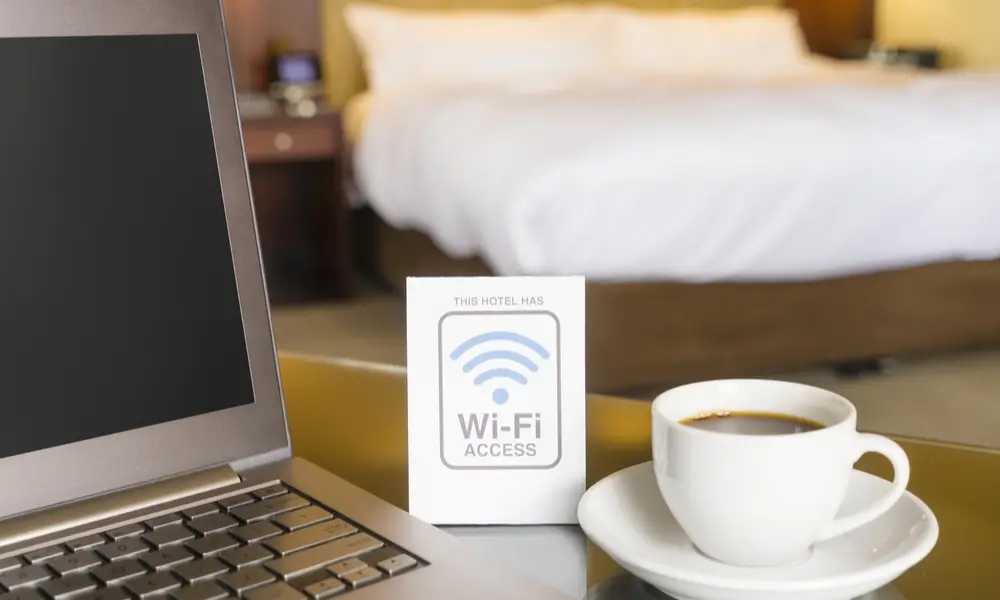From coordinating transportation to linking up with friends to sharing your coolest pictures, your mobile devices pull a lot of weight while you’re traveling. Sometimes, mobile data will be good enough to keep you connected. But it’s important to know where you can access secure Wi-Fi if you want to avoid running up your data usage, especially if you’re traveling somewhere with unreliable mobile data service.
So how can you ensure access to high-speed internet while you’re on the move? We’ll talk about some things
you need to know when hunting for public Wi-Fi — including key security risks and how to mitigate them.
Source: shellygraphy/Shutterstock.com
Where to Go for Free Wi-Fi On Vacation

These are some of the most common places to find public Wi-Fi when you’re away from your home Wi-Fi network:
- Restaurants, bars, and coffee shops
- Airports and public transit stations
- Hotels, resorts, and rentals
- Public libraries and community centers
- Shopping malls and retail stores
- Tourist attractions and museums
- City parks and public squares
Usually, your lodging is the first place to check for Wi-Fi. Nearly all hotels, hostels, resorts, and rentals offer it for free, although quality and security can vary widely. In fact, before you connect to any network, you should always check its security features to make sure you can trust it with your data.
Identifying Secure Wi-Fi

Before you connect your device to any Wi-Fi network while traveling, make sure it’s set up using the right security features that will keep your data safe. These are some steps you can take to verify that the networks you’re using offer acceptable security:
- Check Authentication Requirements: Secure networks should ask users to authenticate their access. This might be through a password, a room number if you’re at a hotel, or a code provided by a purchase receipt in a cafe.
- Check Network Encryption: Look for Wi-Fi networks that use WPA2 or WPA3 encryption. Avoid networks with WEP encryption or unsecured networks that don’t require a password for access.
- Check Network Name: Verify that the network you’re connecting to has exactly the same name as the network you want. Bad actors can impersonate network names to trick you into joining a malicious wireless network.
- Choose Established Businesses: In most cases, more established businesses and institutions will have the most secure Wi-Fi networks. National or global chains are a great place to start looking, as are government buildings.
Risks of Unsecured Wi-Fi

What exactly is so risky about connecting to an unsecured Wi-Fi network? There are a wide variety of risks associated with shady Wi-Fi, but here are a few of the most important:
- Data Interception: Unsecured Wi-Fi can allow hackers to intercept unencrypted data you send and receive, including passwords, emails, and credit card information.
- Malware Distribution: Compromised networks can be used to distribute malware — malicious software that silently infects your device. Malware can have all kinds of bad effects, from stealing your personal data to serving you unwanted ads that you can’t turn off.
- Man-in-the-Middle Attacks: Attackers can insert themselves between you and the connection point, spying on your online activities and potentially altering communications.
Securing Personal Data on Public Wi-Fi
Even when you’re using a secure public Wi-Fi network, it’s smart to be as cautious as possible about how you access personal data. Furthermore, if you’re in an area where you have no choice but to use a less secure network (such as a country with poor internet infrastructure), these steps are absolutely essential to your security. Keep these in mind any time you have to connect to a public Wi-Fi network while traveling:
Use a virtual private network (VPN).

VPN software on your phone helps protect your privacy and prevents your device’s traffic from being intercepted. If you anticipate having to use unsecured networks, it can be useful to purchase a VPN subscription before your vacation — although it’s also worth noting that they can reduce your internet connection speed.
Avoid sensitive tasks like online banking and purchases if you can.
When possible, avoid using any online services that require you to input sensitive personal information, especially things like bank account passwords and credit card information. The less sensitive information you transmit, the lower your risk of having personal information intercepted. When you can’t avoid these tasks, choose the most secure Wi-Fi network you can find, and make sure to log out when you’re finished.
Disable auto-connect features on your phone.
If your device has settings that automatically connect to available Wi-Fi, make sure to disable them before traveling. This will prevent your device from accidentally connecting to an untrustworthy wireless network.
Only visit https sites.

When using public Wi-Fi, restrict your browsing to websites that use HTTPS. This secure protocol encrypts data between your browser and the site, protecting your information from interception. The site should have a padlock symbol in the address bar, which indicates that the site is using HTTPS and your data is secured.
Make sure two-factor authentication (2FA) is enabled on your most important accounts.
Two-factor authentication (2FA) is a security method that gives you an extra layer of protection by requiring two different forms of verification to access an account. Before heading off on your trip, make sure you’ve enabled 2FA on key platforms like bank accounts, email, social media, and anything else with your personal information stored.
Source: ymgerman/Shutterstock.com
The Alternative: Creating a Mobile Wi-Fi Hotspot
Most mobile carriers give you the option to turn your phone into a temporary Wi-Fi access point using mobile data. That means you can actually get free Wi-Fi anywhere you have 4G or 5G service. (If your plan doesn’t include unlimited data, note that a hotspot can run through your monthly data plan fairly quickly if you use it a lot.)
Hotspots generally provide better security options than public Wi-Fi, so if you have acceptable mobile data service where you are, try this before you resort to using any network with less-than-ideal security. Plus, it’s easy to set one up — here’s how to do it on iOS and Android. (Make sure you’ve set up any security features that your hotspot offers.)
In today’s world, we increasingly expect reliable Wi-Fi to be available while we’re traveling. Taking a few sensible precautions about using public Wi-Fi can save you a whole lot of grief and headaches later, so take a moment and think before you connect.




